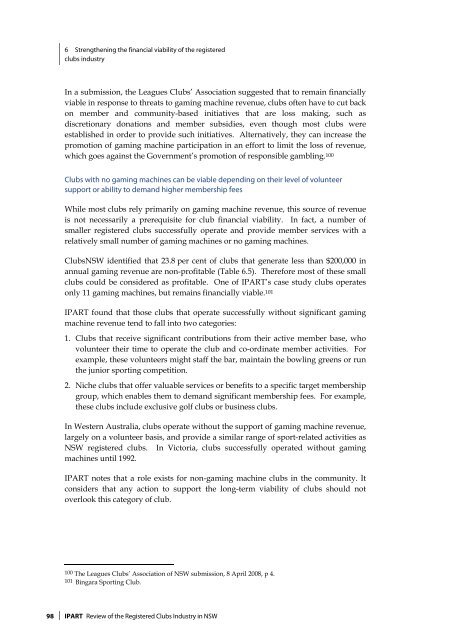Review of the Registered Clubs Industry in NSW - Clubs NSW
Review of the Registered Clubs Industry in NSW - Clubs NSW
Review of the Registered Clubs Industry in NSW - Clubs NSW
Create successful ePaper yourself
Turn your PDF publications into a flip-book with our unique Google optimized e-Paper software.
6 Streng<strong>the</strong>n<strong>in</strong>g <strong>the</strong> f<strong>in</strong>ancial viability <strong>of</strong> <strong>the</strong> registered<br />
clubs <strong>in</strong>dustry<br />
In a submission, <strong>the</strong> Leagues <strong>Clubs</strong>’ Association suggested that to rema<strong>in</strong> f<strong>in</strong>ancially<br />
viable <strong>in</strong> response to threats to gam<strong>in</strong>g mach<strong>in</strong>e revenue, clubs <strong>of</strong>ten have to cut back<br />
on member and community-based <strong>in</strong>itiatives that are loss mak<strong>in</strong>g, such as<br />
discretionary donations and member subsidies, even though most clubs were<br />
established <strong>in</strong> order to provide such <strong>in</strong>itiatives. Alternatively, <strong>the</strong>y can <strong>in</strong>crease <strong>the</strong><br />
promotion <strong>of</strong> gam<strong>in</strong>g mach<strong>in</strong>e participation <strong>in</strong> an effort to limit <strong>the</strong> loss <strong>of</strong> revenue,<br />
which goes aga<strong>in</strong>st <strong>the</strong> Government’s promotion <strong>of</strong> responsible gambl<strong>in</strong>g. 100<br />
<strong>Clubs</strong> with no gam<strong>in</strong>g mach<strong>in</strong>es can be viable depend<strong>in</strong>g on <strong>the</strong>ir level <strong>of</strong> volunteer<br />
support or ability to demand higher membership fees<br />
While most clubs rely primarily on gam<strong>in</strong>g mach<strong>in</strong>e revenue, this source <strong>of</strong> revenue<br />
is not necessarily a prerequisite for club f<strong>in</strong>ancial viability. In fact, a number <strong>of</strong><br />
smaller registered clubs successfully operate and provide member services with a<br />
relatively small number <strong>of</strong> gam<strong>in</strong>g mach<strong>in</strong>es or no gam<strong>in</strong>g mach<strong>in</strong>es.<br />
<strong>Clubs</strong><strong>NSW</strong> identified that 23.8 per cent <strong>of</strong> clubs that generate less than $200,000 <strong>in</strong><br />
annual gam<strong>in</strong>g revenue are non-pr<strong>of</strong>itable (Table 6.5). Therefore most <strong>of</strong> <strong>the</strong>se small<br />
clubs could be considered as pr<strong>of</strong>itable. One <strong>of</strong> IPART’s case study clubs operates<br />
only 11 gam<strong>in</strong>g mach<strong>in</strong>es, but rema<strong>in</strong>s f<strong>in</strong>ancially viable. 101<br />
IPART found that those clubs that operate successfully without significant gam<strong>in</strong>g<br />
mach<strong>in</strong>e revenue tend to fall <strong>in</strong>to two categories:<br />
1. <strong>Clubs</strong> that receive significant contributions from <strong>the</strong>ir active member base, who<br />
volunteer <strong>the</strong>ir time to operate <strong>the</strong> club and co-ord<strong>in</strong>ate member activities. For<br />
example, <strong>the</strong>se volunteers might staff <strong>the</strong> bar, ma<strong>in</strong>ta<strong>in</strong> <strong>the</strong> bowl<strong>in</strong>g greens or run<br />
<strong>the</strong> junior sport<strong>in</strong>g competition.<br />
2. Niche clubs that <strong>of</strong>fer valuable services or benefits to a specific target membership<br />
group, which enables <strong>the</strong>m to demand significant membership fees. For example,<br />
<strong>the</strong>se clubs <strong>in</strong>clude exclusive golf clubs or bus<strong>in</strong>ess clubs.<br />
In Western Australia, clubs operate without <strong>the</strong> support <strong>of</strong> gam<strong>in</strong>g mach<strong>in</strong>e revenue,<br />
largely on a volunteer basis, and provide a similar range <strong>of</strong> sport-related activities as<br />
<strong>NSW</strong> registered clubs. In Victoria, clubs successfully operated without gam<strong>in</strong>g<br />
mach<strong>in</strong>es until 1992.<br />
IPART notes that a role exists for non-gam<strong>in</strong>g mach<strong>in</strong>e clubs <strong>in</strong> <strong>the</strong> community. It<br />
considers that any action to support <strong>the</strong> long-term viability <strong>of</strong> clubs should not<br />
overlook this category <strong>of</strong> club.<br />
100 The Leagues <strong>Clubs</strong>’ Association <strong>of</strong> <strong>NSW</strong> submission, 8 April 2008, p 4.<br />
101 B<strong>in</strong>gara Sport<strong>in</strong>g Club.<br />
98 IPART <strong>Review</strong> <strong>of</strong> <strong>the</strong> <strong>Registered</strong> <strong>Clubs</strong> <strong>Industry</strong> <strong>in</strong> <strong>NSW</strong>
















